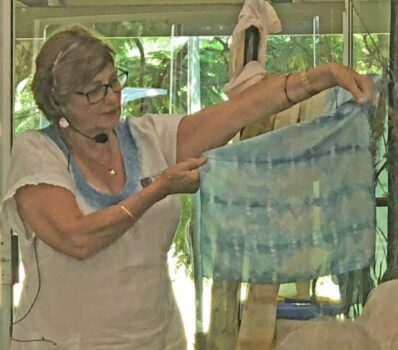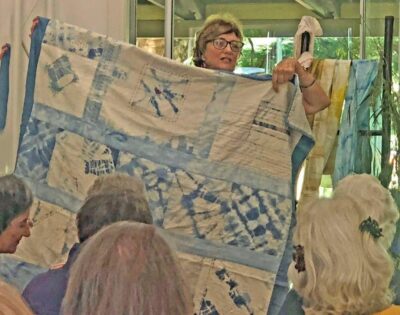- A Master Class in Pruning – Phil Dudman
- Aromatherapy
- Big Scrub Rainforest Plants for Home Gardens
- Bromeliad
- Compost or Worm Wee Tea Recipe
- Cycad
- Feature Foliage
- Floristry
- Gardening Pearls of Wisdom
- Growing vegetables
- Health and Safety in the Garden
- Indoor Plants
- Integrated Pest Management (IPM)
- Native Animals
- Native Plants for Home Gardens on Alstonville Plateau
- Natural Dyeing
- Organic Workshop
- Palms
- Paradise Gardens – Diana Harden April, 2025
- Propagation
Natural Dyeing.
Natural dyeing using plants from our environment is easy but unpredictable. Here are a few simple tips that bring success but keep in mind that the season, growth and plant varieties may impact on the success or not of the dye bath.
- Always choose a natural fibre to dye with. Silk, cotton or wool give lovely varieties of colour when used in the same dye bath. Wash fabric well before dyeing.
- Hot water dyeing is an easy way to get results- boil the ingredients until the water changes colour. Lower the heat, add the fabric and simmer for a further 40 minutes. Leave to cool in the dye bath or rinse in warm water. Toss out the dye.
- I also like to fold and wrap the fabric so that I can lay leaves, turmeric slices, onion skins in a pattern, then wrap tightly around a thick stick and secure well with string or rubber bands. Then immerse into the dye bath and simmer.
- The dyes are permanent. To change the reaction of natural ingredients you can add a mordant to the dye bath. This will create a different colour e.g.; Avocado pits bring a lovely rose colour to the fabric. If you add an iron mordant the colour transforms into inky blues, purples and blacks.
- The three mordants are iron, copper and alum. You can use rusty nails for iron, aluminium foil for alum, and copper pennies or the like for copper. Just add these to the dye bath to change colour.
- Indigo is a more instant dye that is available in synthetic form in kits. Indigo has a rich history and is used in many countries. Indigo replaced dyer’s woad which dates to the Neolithic era. When Indigo arrived from India and Europe around the Cape of Good Hope in the 16th century the dyers preferred it because it was stronger and cheaper, pure, light and compact. Indigo dye gives a blue and was used to dye denim. It is a natural preservative of fibres.
- You can experiment with brown onion skins, avocado pits- rose pink, turmeric slices- bright orange yellow, rosemary sprigs plus iron (inky grey), eucalyptus leaves plus iron (inky purple), loquat leaves- coral pinks and reds.
Many resources are available, and experimenting is an exciting way to explore this topic.


